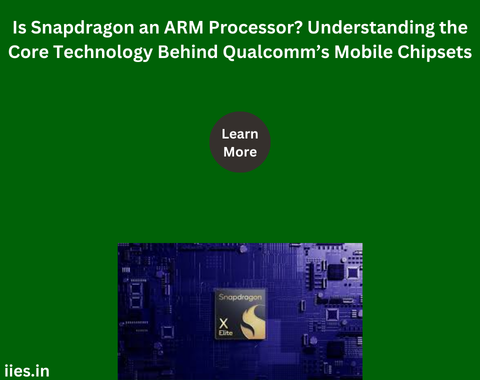What is ARM Architecture?
ARM, which stands for Advanced RISC Machines, is a company that develops a type of processor architecture. Rather than manufacturing chips itself, ARM licenses its architecture to other companies, allowing them to design and produce processors based on this architecture. ARM’s architecture is known for being power-efficient and highly scalable, making it particularly popular in mobile and embedded systems.
The core of ARM’s architecture is based on RISC (Reduced Instruction Set Computing) principles. This means ARM processors use a simplified set of instructions, leading to faster performance and lower power consumption. This focus on efficiency is why ARM-based processors dominate mobile devices, where battery life and heat generation are critical concerns.
Snapdragon: More Than Just a Processor
While ARM creates the architecture that many companies, including Qualcomm, use, Snapdragon is a brand of system-on-chips (SoCs) developed by Qualcomm. An SoC integrates not just the CPU but also other critical components such as the GPU (Graphics Processing Unit), DSP (Digital Signal Processor), modem, and various connectivity modules (like Wi-Fi and Bluetooth) into a single chip. In essence, Snapdragon chips are more comprehensive than just a CPU—they represent a full suite of capabilities designed to power mobile devices.
Thus, Snapdragon is not merely an ARM processor but a complete platform that includes an ARM-based CPU along with various custom components designed by Qualcomm. These components work together to manage everything from computing tasks to graphics processing and wireless communication.
Snapdragon and ARM: The Connection
At the heart of every Snapdragon SoC is an ARM-based CPU. Qualcomm licenses the ARM instruction set and, in many cases, ARM CPU designs. Qualcomm either uses standard ARM cores, such as the Cortex-A series, or develops custom cores based on ARM architecture.
There are two primary approaches Qualcomm takes in using ARM technology in its Snapdragon SoCs:
Standard ARM Cores: In many Snapdragon chips, Qualcomm uses stock ARM designs like Cortex-A53, Cortex-A55, Cortex-A76, and Cortex-X1, which are widely found in various devices across the market. These designs are optimized for performance and power efficiency, making them ideal for mobile applications.
Custom ARM Cores: Qualcomm also designs its own custom cores based on ARM’s instruction set, branded under names like Kryo. These custom cores are tailored to deliver a balance of performance, efficiency, and integration with Qualcomm’s other technologies. While the custom cores still follow the ARM architecture, Qualcomm modifies them to suit its specific performance and power management goals.
Customization Beyond the CPU: The Role of the Adreno GPU and Hexagon DSP
While the CPU in a Snapdragon SoC might be based on ARM technology, Qualcomm introduces its own innovations in other components, such as the Adreno GPU and Hexagon DSP.
Adreno GPU: Unlike ARM’s Mali GPUs, which are used by other chipmakers, Qualcomm designs its own GPUs under the Adreno brand. Adreno GPUs are optimized for mobile gaming, graphical tasks, and power efficiency, often giving Snapdragon SoCs a competitive edge in graphics performance.
Hexagon DSP: The Hexagon Digital Signal Processor (DSP) is another custom Qualcomm component that distinguishes Snapdragon from other ARM-based SoCs. Hexagon is designed to handle specialized tasks, such as audio processing, sensor management, and increasingly, AI and machine learning workloads. This DSP enables efficient offloading of tasks from the main CPU, further improving overall performance and battery life.
Snapdragon’s AI Capabilities
In recent years, Qualcomm has heavily invested in artificial intelligence (AI) and machine learning capabilities for its Snapdragon SoCs. This effort is encapsulated in the Qualcomm AI Engine, which leverages multiple components within the SoC, including the ARM-based CPU, Adreno GPU, and Hexagon DSP, to deliver efficient AI performance.
AI tasks such as voice recognition, real-time translation, and image processing benefit from Snapdragon’s integration of ARM architecture with Qualcomm’s custom components. By distributing AI workloads across various parts of the chip, Qualcomm achieves performance improvements and energy efficiency that are essential for mobile devices.
Snapdragon’s Modem Integration
One of the standout features of Snapdragon SoCs is the integration of Qualcomm’s modems, including the latest 5G-capable models. Qualcomm is a leader in cellular technology, and Snapdragon chips are often among the first to support cutting-edge connectivity features like 4G LTE, 5G, Wi-Fi 6, and Bluetooth 5.0.
Unlike ARM, which focuses primarily on the CPU architecture, Qualcomm’s Snapdragon SoCs integrate advanced modem technology, making them well-suited for smartphones, tablets, and even laptops that require fast and reliable connectivity.
How Snapdragon Stacks Up Against Other ARM-Based SoCs
The ARM architecture powers numerous mobile processors from different manufacturers, including Apple’s A-series, Samsung’s Exynos, and MediaTek’s Dimensity. While all of these processors use ARM-based cores, Qualcomm’s Snapdragon series stands out due to its customization and integration of various technologies.
For example, Apple uses ARM-based cores but designs them entirely in-house, leading to highly optimized performance for iPhones and iPads. Samsung’s Exynos and MediaTek’s Dimensity also use ARM-based cores, but the level of integration and customization differs. Qualcomm’s deep integration of its custom CPU cores, Adreno GPU, Hexagon DSP, and modem technology provides a compelling blend of power, efficiency, and connectivity that has made Snapdragon the go-to choice for many Android devices.

